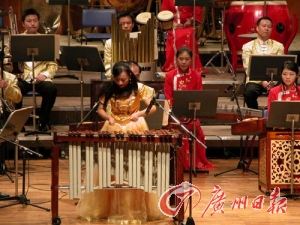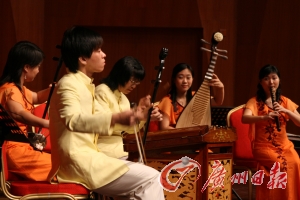more>>More News
- National Day
- ways to integrate into Chinese style life
- Should they be in the same university with me?!!
- Chinese Ping Pang Legend: the Sun Will Never Set
- A Glance of those Funny University Associations
- mahjong----The game of a brand new sexy
- Magpie Festival
- Park Shares Zongzi for Dragon Boat Festival
- Yue Fei —— Great Hero
- Mei Lanfang——Master of Peking Opera
Title Music of Guangdong: Always
By admin on 2014-12-19
Guangdong music took shape from the end of Qing Dynasty to the early years after the Republic of China was established in 1912. The early troupes were made up of performers from local opera troupes, as well as performers from the "Eight-tone Troupe" who were peasants at the same time. Guangdong music became prevalent and influential in the 1920s, performed mainly at wedding banquets, funerals and as well as before and during the screening of silent films. As it is often played in hilarious occasions, Guangdong music remained quite "sporty". Since the 1930s, the Guangdong music has become more commercialized by playing in teahouse and dance halls and thus more "upbeat".
Guangdong music is a kind of "title music", which means the audience can understand its theme from the title.
The early ensemble of Guangdong music was the same as that of the local opera music. It consisted of Erxian (two-string), Tiqin (an instrument similar to Banhu but of bigger size), Sanxian (three-string), Yueqin and horizontal flute, which were called the "Five Pieces" or "Hard Bow Group". In 1926, Guangdong musicians and composers started to use Erhu (called Yuehu, which means Cantonese Erhu, with the outside string changed into a steel string, and the instrument is held between player's legs.) from the Jiangnan Silk and Bamboo Music in Shanghai, Qinqin from Chaozhou, and Yangqin from Guangzhou to make the "Three Pieces". Later, complemented with Dongxiao and Yehu, the "Three Pieces" were turned into the new "Five Pieces". The "Three Pieces" and the new "Five Pieces" were also called the “Soft Bow Group”. The "Soft Bow Group” was more suitable to play sporty and upbeat music pieces, including some popular representative pieces such as Dragon Contending for Brocade by He Liutang, Stepping High and Waking Lion by Lv Wencheng.
Many virtuosi in early days were specialized in string instruments. For example, Yan Laolie and Qiu Hechou played the Yangqin, and He Liutang played the Pipa. As a result, many popular music pieces at that time had a lively and dynamic rhythm. The representative works at that time include Thunder in the Dry Season, Galloping on Horseback, and Getting off Fishing Boat, etc. The latter two describe specific sports and outdoor activities.
The period between the 1920s and the 1930s was Guangdong music's heyday of evolvement and prevalence marked by large quantities of original pieces composed by folk musicians on the base of re-editing traditional works. He Liutang, one of the representative musicians in the 1920s, wrote his famous work Dragon Fighting for Brocade with ordinary people's sport activities a source of inspiration. In the middle of the 1920s, Lv Wencheng, another renowned performer and composer in the history of Guangdong music, re-edited nearly 200 music pieces, making a new step forward for Guangdong music. Many of his well-known works, such as Stepping High and Waking Lion, had a sport theme. There were many other excellent works at the same time, The Lion Rolling a Ball and Two Dragons Contending for a Pearl, for example, also described exciting sports events.
After the founding of the People's Republic of China, Guangdong musicians produced a lot of fresh music pieces that truly reflected reality. Besides the traditional solo and unison,there were also concerto as well as concerto grosso. Many excellent works, such as Spring Comes to the Farmland, Horse Riding on the Outskirt in Spring and Weaving a Rainbow Miles Long, were created, of which, Horse Riding on the Outskirt in Spring by Chen Deju was an outstanding piece about sports.
According to experts in the field, Guangdong music is a kind of "title music", which means the audience can understand its theme from the title. There are around three types of Guangdong music with sports theme. The first type is about traditional works, such as Flower Drum Dance, Rowing Boat and The Dragon Soars and the Phoenix Dances, which were inspired by traditional sports and outdoor activities.
The second type is the so-called "clang music" prevalent in the heyday of Guangdong music between the 1920s and the 1930s. The representative works include Dragon Fighting for Brocade by He Liutang, Waking Lion and Stepping High by Lv Wencheng, as well as Carnival by Chen Wenda. Some traditional works with loud and dynamic sounds such as Galloping on Horseback and Getting off the Fishing Boat became popular in this era, which in some way reflect the "carnival of ordinary people" in early days.
The third type includes works that describe a specific kind of sports. For example, "Breaking the Disposition of Troops",by Lv Wencheng, a member of "The Four Kings" in the period of Republic of China (the other three are Yin Zizhong, He Dasha and He Langping.) features athletics while his Dance in Feathery Clothing features the basic elements of rhythmic gymnastics. Another example is Soaring through the Clouds by He Taisha, which, as an encouraging piece of work, has been re-edited again and again.



- Contact Us
-
Tel:
0086-571-88165708
0086-571-88165512E-mail:
admission@cuecc.com
- About Us
- Who We Are What we do Why CUECC How to Apply
- Address
- Study in China TESOL in China
Hangzhou Jiaoyu Science and Technology Co.LTD.
Copyright 2003-2024, All rights reserved




 Chinese
Chinese
 English
English
 Korean
Korean
 Japanese
Japanese
 French
French
 Russian
Russian
 Vietnamese
Vietnamese
